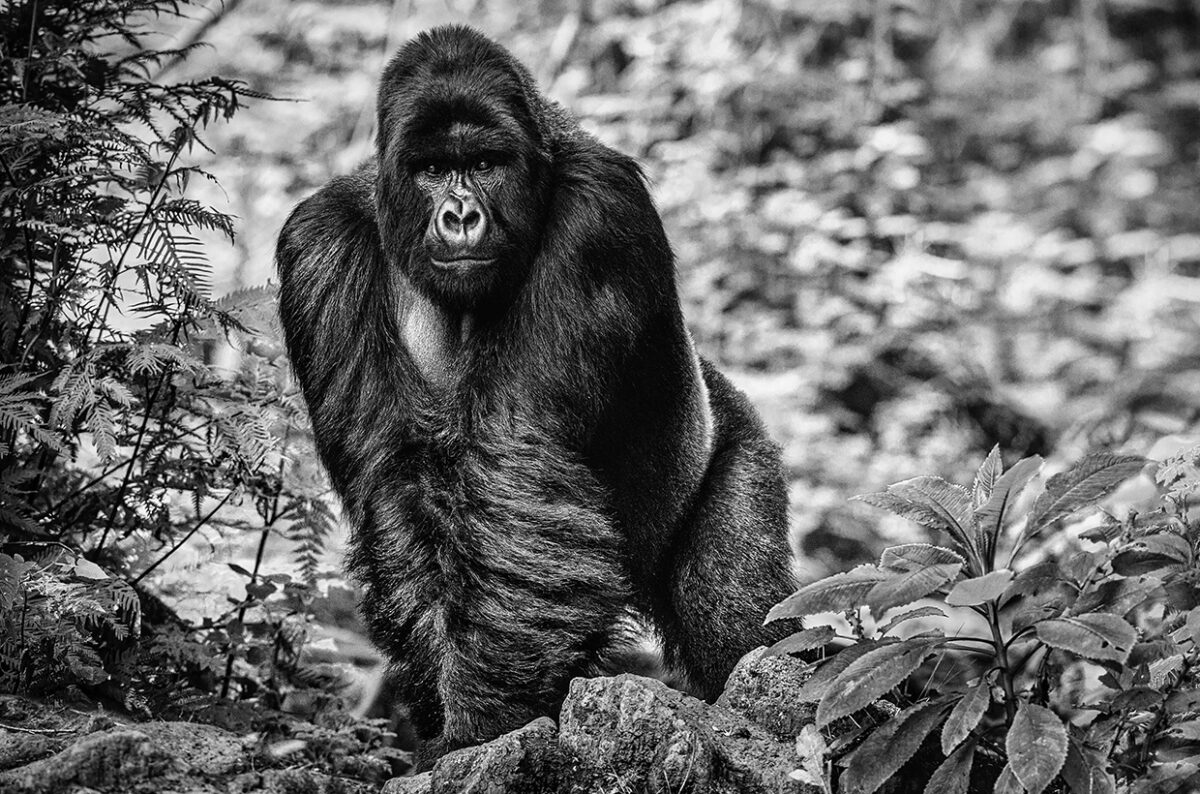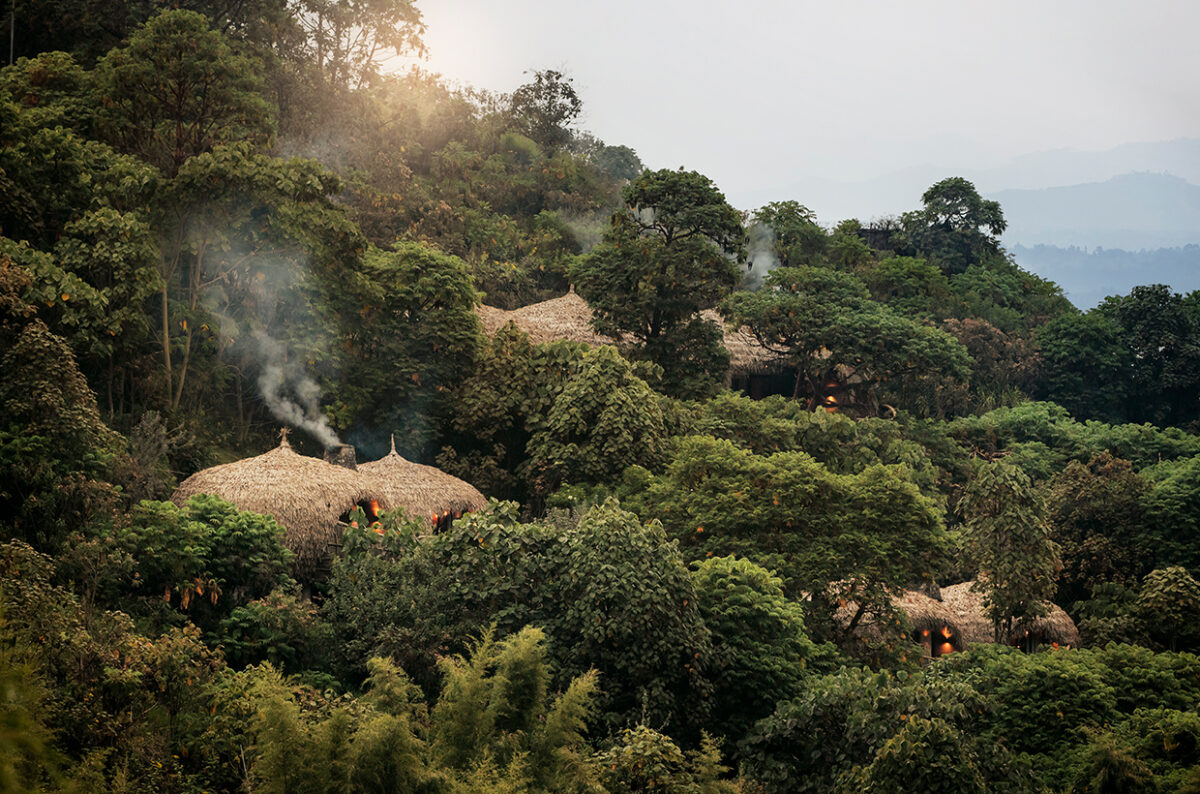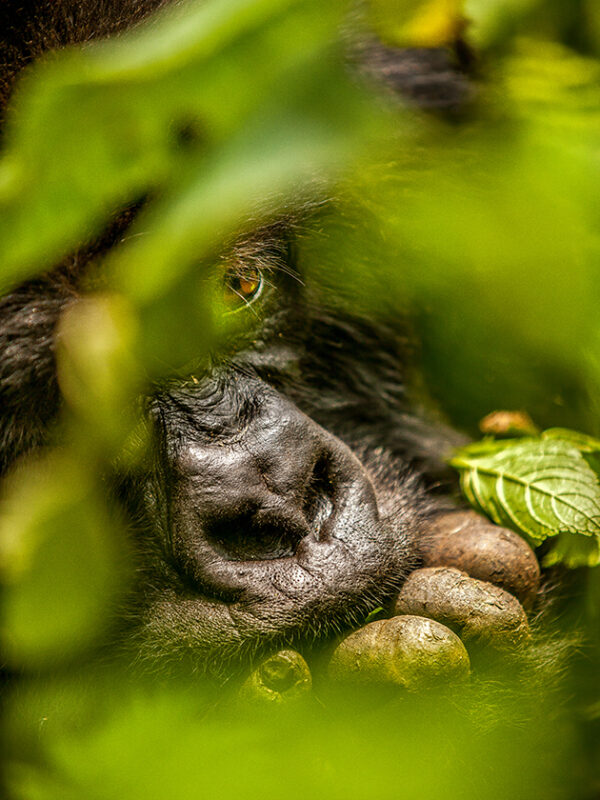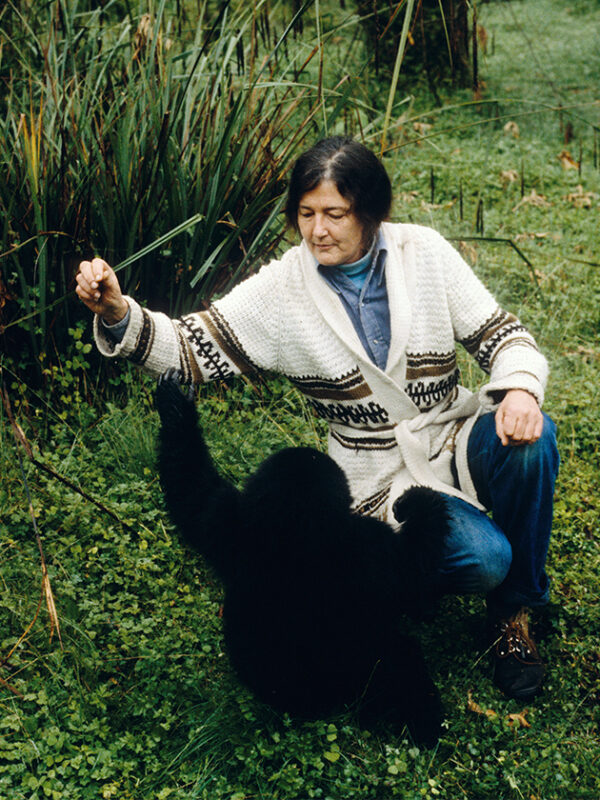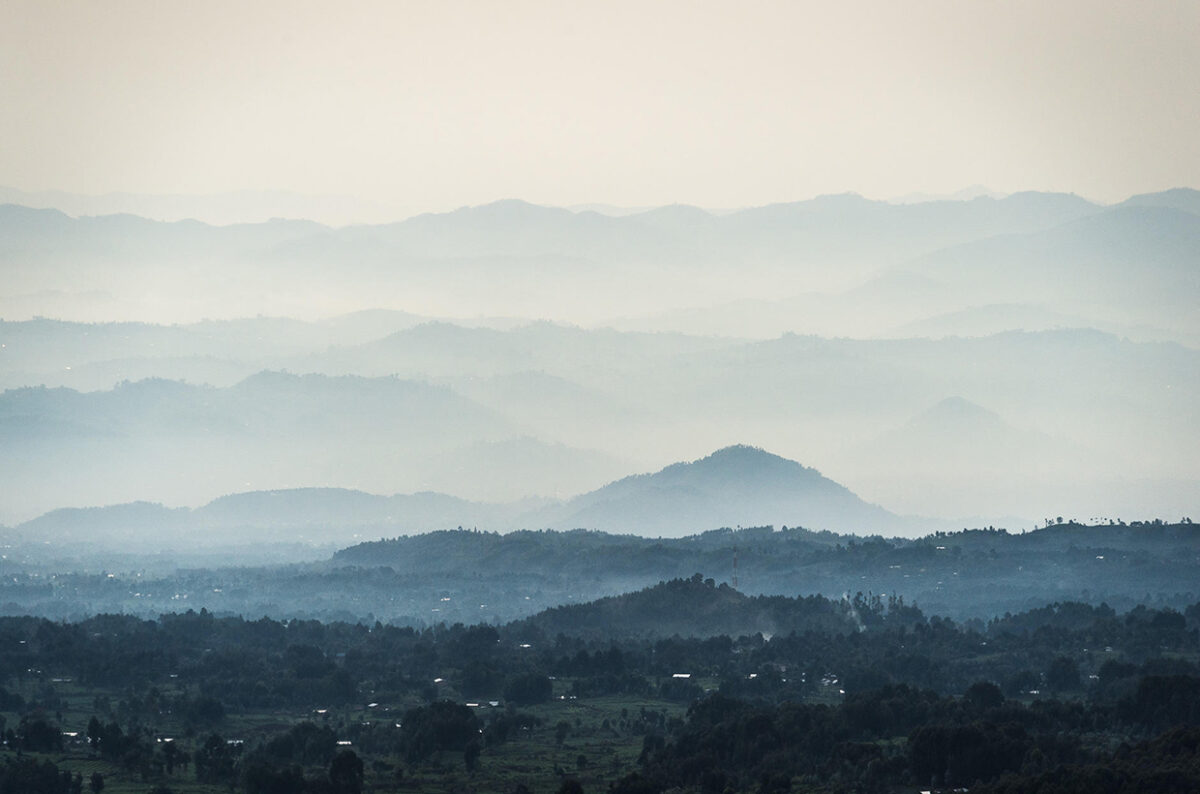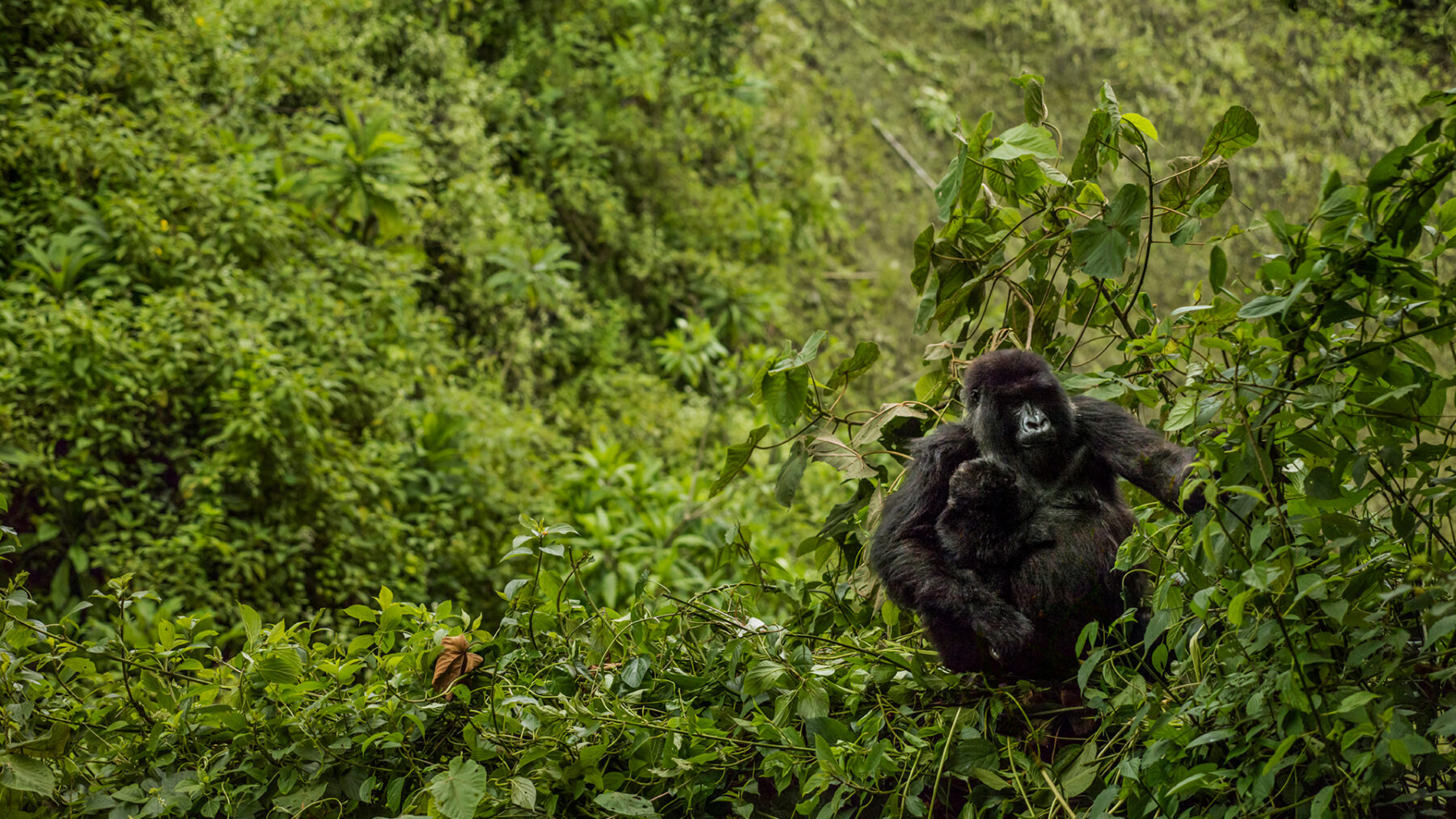A visit to the world of Dian Fossey by Michaela Cordes | 21st March, 2023 | Personalities
Oh look! There’s a rustling in the bushes behind us, and I suddenly see a hand covered with thick black hair reaching out for a bamboo branch, followed by a satisfied smacking sound. “Stay very still,” says Ignacius, my guide, making a deep, rolling mhhh-mhhhh noise. That’s gorilla language and means: I feel good and won’t hurt you. While the big silver- back is munching on his favorite plant, a small- er gorilla takes up a position right behind me.
I slowly turn around to face him. He gives me a shy but interested look and then walks on all fours back into the rainforest. “Come on!” says Ignacius, following the blackback (a male gorilla that will turn into a silver- back when it is older) through the thicket. He uses his machete to clear a path through the tangled undergrowth. I follow, lowering my head to avoid the prickly leaves but shudder a little at the sight of the machete. The weapon of choice of the poachers who used to kill countless mountain gorillas in Rwanda until very recently; it was also used in the brutal killing of a million people in just 100 days during the tragic genocide here roughly 29 years ago.
It is the darkest chapter in this country’s history where nearly everyone lost at least one relative. But despite the pain, the people of Rwanda are making a conscious effort to turn away from the hatred toward a bright- er future. As a result, Rwanda has developed into one of Africa’s most modern countries: Women hold 65 percent of the seats in par- liament, the capital Kigali is the cleanest city on the continent, where plastic bags were banned as early as 2008, and the protection of mountain gorillas has become a top priority.
“We have chosen forgiveness over re- venge,” says my driver Emmy, as we travel from Kigali to Bisate where I originally started my gorilla track. On our way there Emmy points out the many modern speed cameras, which I am familiar with from Germany. Located a few kilometers apart, even on country roads, they are responsible for bringing down the high numbers of traffic fatalities. There are also over 200 genocide memorials scattered throughout the country, proclaiming to the world that what happened here must never happen again.
The country of Rwanda has undergone an equally transformative change of heart about its most treasured inhabitants. Dian Fossey, who carried out an aggressive campaign against Rwanda’s lax attitude to poachers in the 1970s and warned that the mountain go- rillas would be extinct by the end of the 20th century, is today celebrated as a hero.
So it comes as no surprise that if you want to visit the mountain gorillas, you need to be patient. Because this experience is so unique, it is highly sought after and there is a long waiting list. Only 12 of the existing 20 gorilla families can be visited by tourists. And only eight people are allowed per family for one hour. “We have guests booking up to two years in advance,” says Ingrid Baas, operations manager at Wilderness Rwanda. Opened in 2019, their beautiful lodge Bisate in the Volcano National Park is booked con- tinuously and is regarded by experts as one of the finest lodges for gorilla trekking. After a short, restless night in my pleasant, tastefully decorated lodge – one of several protruding from the hillside like beehives – I got up at 5 a.m., packed my waterproofs and gloves (for protection from thorny bushes) into my back- pack and pulled on the waterproof hiking boots and gaiters (to prevent insects crawling up into my shoes). I then met my driver Emmy again who drove me by jeep to the gorilla tracking meeting point, where I was as- signed to one of the 12 groups.
Equipped with a (beautifully carved) walk- ing stick, a lunch box and water bottle we began our ascent. Led by three guides, our group of eight walked across fields of beans and potatoes that had been planted by local farmers at the foot of the 3,669-meter-high Sabinyo volcano. A fact that makes transpar- ent how far humans have encroached into the mountain gorillas’ habitat. Mount Sabinyo is one of eight volcanoes in the Virunga Moun- tains and extends into Rwanda, Uganda and the Democratic Republic of Congo. The three adjoining countries are where the mountain gorillas live. The last official count identified 1,060 of them in the Virunga Mountains. This is a gratifying result as there were only 250 left during Dian Fossey’s time.
It is nearly lunchtime on this sunny De- cemberday in the Volcanoes National Park in northwestern Rwanda that is now home to 20 mountain gorilla families. It’s 24 degrees Celsius and there isn’t a rain cloud in sight. Just before we encounter the gorillas, we are urged to put on our masks to protect these rare animals, which share up to 98 per- cent of their DNA with us humans. Ignacius: “Since we made mask-wearing obligatory, our gorillas have been ill much less frequently. And not just because of the COVID pandemic. The gorillas are susceptible to other common human diseases too.”
Mountain gorillas are plant eaters and have their first meal around 10 in the morning after leaving their night nest. They spend about five minutes each evening building a new nest from branches and leaves (for hygienic reasons, as they also use their nest as a toilet). The time window after their first meal is the best time to visit the gorillas. That’s when they are satisfied and tired, which is hardly surprising, as a fully grown, 1.70-meter tall silverback can polish off as much as 30 kilograms of plants in a day.
Nowadays, the large primates have no predators to fear – unlike in Dian Fossey’s day when their main enemies were corrupt game hunters who went out to hunt to kidnap a baby gorilla. In her detailed articles in pub- lications like National Geographic, the Amer- ican researcher brought this brutal slaughter to the attention of the international public.
Gorilla families – one should know – will fight ferociously to protect their young. Because of this, poachers often had to kill an entire family to capture a single baby gorilla, which they would then sell for the best price to a Western zoo. A family can consist of as many as ten to twenty members, which goes a long way to explain the drastic decline in the mountain gorilla population during Fossey’s time. “Luckily, since those times, zoos have learned that mountain gorillas cannot survive anywhere else than here – in their native habitat,” explains Ignacius.
This is also why the government of Rwanda has put all of its energies into protecting the mountain gorillas, introducing severe penal- ties for poaching and publicly supporting the Karisoke Foundation that Dian Fossey found- ed in 1967. Since renamed the Dian Fossey Gorilla Fund, countless celebrities have donated generously to the preservation of these endangered animals. The most famous one is TV host Ellen DeGeneres, who was so impressed and touched by her first mountain gorilla adventure that she had an ultramodern museum dedicated to Dian Fossey built in Bisate called The Ellen DeGeneres Cam- pus of the Dian Fossey Gorilla Fund in honor of the mountain gorilla and to help educate visitors about them. After opening in February 2022, personalities like Formula 1 driver Lewis Hamilton and actor Harrison Ford have been humbled by their encounters with the mountain gorillas.
Today, the foundation gives 10 percent of its tourist income to the state, which in turn lets every inhabitant of Rwanda participate in the gorilla tourism revenues, thus thwart- ing the poachers. On top of that a team of local scientists and doctors works round the clock to expand our knowledge of mountain gorillas. Eight of the 20 gorilla families liv- ing here are observed exclusively for scientific purposes.
To follow the gorillas, the “gorilla trackers” – specialists who also document the health and habits of these animals on a daily ba- sis – look out for the Kwisanga gorilla fami- ly, which I am allowed to visit today. Ahead of us, and using walkie-talkies, the trackers tell our guides exactly where we need to hike.
Kwisanga means “feel at home” and the name is derived from this family’s unusual history. “What is unusual about them is that there are two silverbacks in this gorilla family. They arrived here from Congo 15 years ago and never returned,” explains Loyce, the assistant manager of Wilderness Bisate Lodge, speaking to me later that evening. She previously spent 11 years working as a guide at Volcanoes National Park. To become a gorilla guide, she says, you have to undergo extensive training and meet very high standards. Only 17 out of 1,000 applicants make it to the final selection each year.
We notice the vegetation becoming wilder as soon as we enter the rainforest at the foot of the volcano. There are also elephants and buffalo living here who can sometimes become a threat to tourists. “Yesterday, while I was leading a group, one of the guests got nervous and tried to run away when the elephants came charging towards us,” one of the trackers tells me. Unexpected things can happen if visitors reach the gorillas before the trackers do. “You have to remember that these are wild animals,” warns Loyce, who has only ever once encountered a really aggressive gorilla family during her years as a guide. “We later learned that the baby of that family had been caught in an antelope trap, which left the whole family in agony.”
There are no signs of any disturbance when we finally catch our first glimpse of the Kwisanga family that I am visiting today. Instead, I sense a kind of harmonious fatigue. Just as it begins to rain, up on a lush green hill, I spot a fluffy baby gorilla, relaxed and yawning as it snuggles up to its sleeping father – the second silverback in the family. A few seconds later another young gorilla comes stumbling out of the bamboo bushes and sits down right in front of me. As a visitor, you’re asked to keep a distance of at least seven meters. But if the animals approach you, just stay where you are, Ignacius explained to us during the hike here. So I stay very still and maintain my position. Suddenly, I find myself so close to the teenage gorilla that I could reach out and touch it. But unlike Dian Fossey, who documented her amazing work with mountain gorillas
